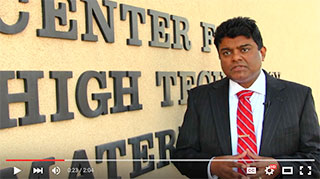Recent News
CHTM Joins NSF's NQVL Pilot Projects
August 9, 2024
OSE PHD, Dr. Xuefeng Li - Wins The Outstanding Interdisciplinary Graduate Programs Award
May 10, 2024
Dr. Ali Rastegari - 2024 OSE Best Dissertation Award Winner
May 10, 2024
2024 OSE Spring and Summer Graduates
May 10, 2024
News Archives
Outgoing CHTM Director Sanjay Krishna celebrates 26th successful PhD candidate at UNM
January 3, 2017 - Sharon Steely
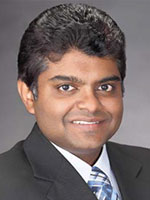
Sanjay Krishna served as the director of the Center for High Technology Materials (CHTM) at the University of New Mexico (UNM) from August of 2013 until July of 2016. in 2016, he was recruited by The Ohio State University for an endowed chair position in their Electrical and Computer Engineering department. He departs for Ohio State on January 6, 2017.
Krishna will continue as co-advisor for two UNM doctoral students, Lilian Casias and Zahra Taghipour, until they complete their dissertation. Although he will not take on any new projects here, he has a few grant-funded projects to complete at CHTM. For the Spring semester of 2017, he will return to New Mexico and CHTM frequently. The UNM Office of Academic Affairs offered Krishna a Letter of Academic Title to retain his professional connection with UNM and CHTM.
"The fact that I got recruited from here says a lot about New Mexico. It says that the big schools are looking at the talent pool that’s here. Our students get recruited, our faculty get recruited. That’s a good indicator of UNM's quality," he states.
"This opportunity with Ohio State came out of the blue," said Krishna. "I was not looking — but at their invitation I went out there and got sold on the vision." Krishna says one of the big tipping points was considering the timing for his two boys, Surith, 12, and Sarthak, 10, who are about to start middle school. He says the larger community and the Ohio school system will give them a bigger platform for their own growth. "With my own students, I always encourage them to go out and see the world when they have the opportunity."
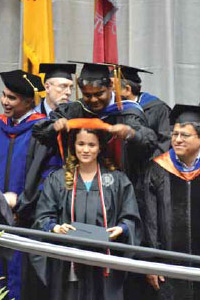
Krishna decorates UNM doctoral student Lilian Casias for her Masters' degree
Professor
Krishna's role as a professor has always been first and foremost in his motivation. "It's because of the students, watching them grow," he says. "They walk into your office that first day, and they don't know what they are doing. Then you see them blossom, and five years later, they are very different. As a grad school advisor, you become their academic parent."
"The science is very important — but the people are probably more important. You sit down with a student, and they are dealing with not just hard scientific problems, but hard people problems. You’re working in an environment where they may be apart from family. It's important to have empathy to appreciate what they are going through."
In December of 2016, Krishna celebrated the 26th successful PhD candidate that he has advised at UNM, Vince Cowan. Dr. Cowan is an Electrical Engineer with the New Mexico Air Force Research Lab (AFRL). Krishna's post-docs have gone on to successful careers at high-end technology assets such as Sandia National Laboratories, the AFRL, and New Mexico technology startups. Dr. Stephen Myers, who earned his PhD at UNM in Nanoscience and Microsystems under the supervision of Krishna, is the Senior Research & Development Engineer at SK Infrared, where he is developing infrared detection systems and medical imaging application techniques.
His students gain vital experience as members of the Krishna Research Group, whose mission is to develop next generation infrared imagers using nanoscale materials and device architectures. Students pursue their own research projects as part of the team. For example, Casias works with the Research Group on developing novel Ga-free Long-Wave Infrared (LWIR) based on an InAs/InAsSb type-II strained layer superlattice (T2SL) material system with the support of the Naval Research Labs (NRL) and the Army Research Office (ARO). As a Graduate Researcher at CHTM, Casias' work encompasses infrared detectors, avalanche photodiodes, Cleanroom single pixel devices processing, fabrication, optoelectronics, characterization of devices (spectral response, responsivity, dark current), and other areas.
UNM career highlights
After completing his PhD in Applied Physics from the University of Michigan in 2001, Krishna joined the UNM Electrical and Engineering Department (ECE) as an Assistant Professor in July of 2001. In 2006, he advanced to Associate Professor with ECE. In July of 2010, he was selected as a Professor and UNM Regents Lecturer with the ECE Department.
Krishna served as Associate Director of CHTM from 2009 - 2012, under the Directorship of Steven R. J. Brueck.
Krishna has received many peer-reviewed awards, including the 2002 Ralph E. Powe Junior Faculty Award from Oak Ridge Associated Universities, the 2003 IEEE Outstanding Engineering Award, the 2004 Outstanding Researcher Award from the UNM ECE Department, the 2005 School of Engineering Junior Faculty Teaching Excellence Award, the 2007 North American Molecular Beam Epitaxy Young Investigator Award, the 2007 NCMR-DIA Chief Scientist Award for Excellence, the 2008 Early Career Achievement Award from the SPIE and IEEE Nanotechnology Council, the 2009 Sr. Research Excellence Award from the UNM School of Engineering, and the 2010 UNM Teacher of the Year Award.
Krishna has authored/co-authored more than 80 peer-reviewed journal articles, over 50 conference presentations, four book chapters and has ten issued patents. He is a Fellow of SPIE, IEEE and OSA.
In March of 2016, four UNM startups, including three originating at CHTM in the area of photonics, were among six startup companies to receive $300,000 in first round funding from the New Mexico Economic Development Office's Technology Resource Collaborative (TRC). Krishna welcomed Governor Susana Martinez to CHTM, where she made the announcement.
Research
"I think it is a matter of balancing the depth and the breadth," says Krishna. "The PhD gives you the depth, right? You are really good at certain things, at a level of detail. That comes at the expense of the breadth. Make it a priority to be able to lift your head up and see what other people are doing. It's important not only to do the science but to contextualize it for people, reach out to the community and talk about it. Otherwise we get isolated in an ivory tower."
"We get so lost in our TLAs — 'three letter acronyms.' That is where we lose people. We can help them be aware of the general benefit of the technology."
Krishna met his wife, Sanchita, at the Tata Institute of Fundamental Research in Mumbai, India. He said, "In India, when you are doing very well, especially in physics, the smartest kids go into theoretical physics. They do what is called string theory (a fascinating business). I realized that string theory or fundamental physics didn’t really appeal to me, because I really wanted to do more of applied physics. I wanted to be able to say in my thirty years of career, 'this is what we did.' So our Research Group is really on the boundary between applied physics and engineering."
There are three main aspects to the research conducted by Dr. Krishna and the Krishna Research Group:
- The first is fundamental materials: use of Molecular Beam Epitaxy (MBE) to develop antimonide-based materials and devices. "We do some really cool science, building materials atom by atom."
- "Then we take these materials, and put them into cameras and focal plane arrays. We make the detectors, and that’s been our strength."
- "The third aspect, which I really want to expand in my role in Ohio, is to really look at new applications of infrared imaging. We take these cameras we have and purpose them for new applications. One thing that really tugged at my heart was the use of infrared imaging for early skin cancer detection, which we developed with SK Infrared. The medical application was really fascinating but I am really looking at “dual use” applications — not just for defense and security, but also for commercial applications. In my mind, that justifies why we are doing all of this — it is for the benefit of society as a whole."
CHTM Director

Dr. Brianna Klein, one of Krishna's successful PhD candidates through CHTM, who is now with Sandia National Laboratories, operates an MBE as a post-doc research assistant at CHTM
CHTM is an internationally recognized center for photonics and microelectronics, and the facility provides invaluable resources for researchers in the areas of photonics, optoelectronics, microelectronics, and nanoscale materials and devices. The Krishna Research Group has depended on CHTM's Crystal Growth machines, the Cleanroom, and other equipment for electrical and optical characterization. CHTM supplies high-quality group III-V semiconductor materials such as GaAs, AlGaAs, GaInAs, InP, InAs and InAsSb, which is one of the key limiting factors in producing semiconductor materials and devices.
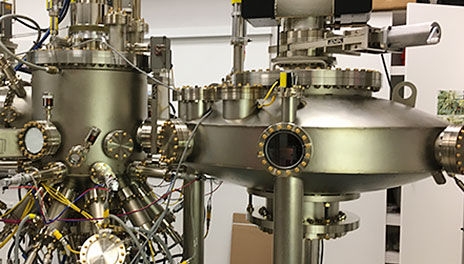
The Veeco Gen10 MBE at CHTM
In 2010, CHTM and the Krishna Research Group celebrated the arrival of a new Veeco GEN10 MBE, a specialized state-of-the-art molecular beam epitaxy machine (MBE) that allows researchers to grow complex crystals with superior quality control. An MBE reactor is an advanced ultra-high-vacuum environment (basic pressure 10-13 bar) to make compound semiconductor materials with great precision (< 0.01 nanometer) and purity (>99.99999%). At CHTM, the MBEs are used to grow superlattice samples and quantum structures such as quantum dot (QD), quantum well (QW), and quantum dot in a well (DWELL). The Veeco Gen10 MBE was the first machine of its kind available for use in a university setting in the United States.
CHTM provides a collaborative learning environment and a superb educational opportunity for graduate and doctoral students, allowing them to gain an in-depth experience of their research topic. In addition, they have the opportunity to interact with peer groups and to establish a professional network though conference and meeting presentations. This experience gives graduating students a competitive "edge" as they enter the job market. "CHTM provides one of the few university laboratories in the country that have an end to end integration from design, crystal growth of material, device fabrication and focal plane array development into infrared cameras,” Krishna said. “This rounds off the learning experience for the student to enable them to get a breadth of ‘material to manufacturing’ experience.”
"The CHTM Directorship was my way of giving back," says Krishna. "It is a service that you do. But my real motivation, what wakes me up in the morning, is being a professor." Krishna frequently expresses that his greatest satisfaction comes from seeing the growth in the lives of his students and others around him.
"When you have positions of power, of leadership, what they give you is an opportunity to make a difference on a bigger scale," says Krishna. "When I took on the directorship, apart from being able to do my research, what was appealling about the job is the whole idea that my passion is to make a difference."
"One of the big differences I could make as a director was to hire good people. Recruitment is critical; recruitment of faculty, staff and students." As CHTM Director, Krishna served as a hiring official for three CHTM faculty members — Arash Mafi, Victor Acosta and Francesca Cavallo. "I feel it is a huge compliment to the committee to see Arash step up to the role and take on the directorship. He has a very good temperament and a very good leadership style. I wish him well. It is another opportunity for me to enjoy someone's growth in their career. He came into UNM as a faculty member and researcher, and now he is picking up the torch as a leader."
"I wouldn’t have had that opportunity if I had not stepped up. Being in a leadership position, you can make a bigger impact."
A new stage
"At Ohio State University, I am hired as part of a discovery team, which basically means I would be housed in electrical engineering, but I would be cutting across disciplines and talking to people. They have a very good medical school program. So, really, finding new applications for infrared imaging is one of the things I would like to beef up in my research profile. It is basically all about the research."
"I think my best work is yet to come. I’m just getting started. I’ve learned so many things; there are so many things I can do right. I’ve made mistakes and learned from this and I will incorporate that into my new job."
Ohio State asked Krishna about taking on an administrative position. "I said, not right now. I want to be a professor and do good work. If leadership opportunities come up in the future, obviously that is something that I’ll keep open. I am going to a bigger stage and expectations are going to be different. For now, I am looking forward to setting up my lab and being with the students." Among the people who will accompany Krishna to Ohio State are Sen Mathews, a Research Scientist specializing in MBE Growth; Alireza Kazemi, who completed his PhD in Optical Science and Engineering at UNM in 2016; and students Seunghyun Lee and Vinita Dahiya.
"I think that has been my biggest strength: having a great team. I surround myself with people who are better than me — just really good human beings."
"I have been in New Mexico for 15 years. I still love New Mexico and I love the Southwest and I will have opportunities to come back."
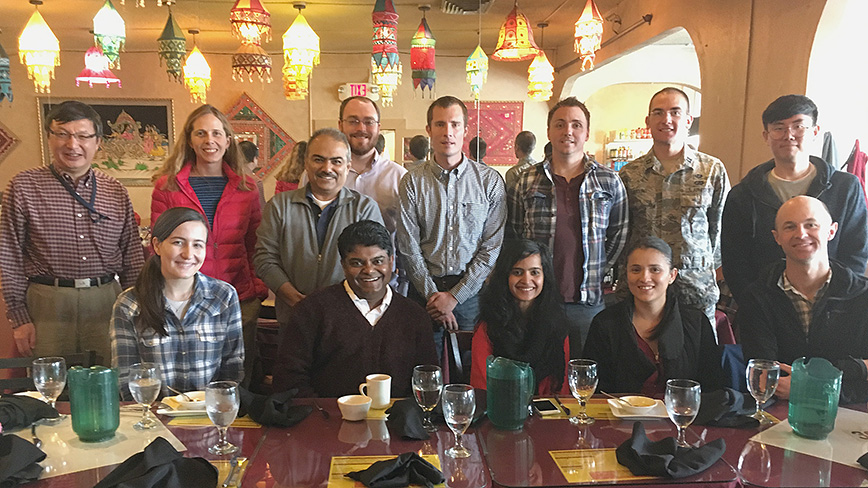
Sanjay Krishna celebrates his 26th successful PhD candidate at UNM (Vince Cowan, standing to Krishna's left) with his students and colleagues in December 2016



